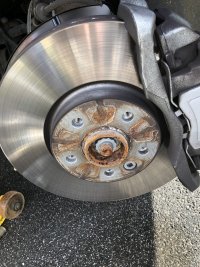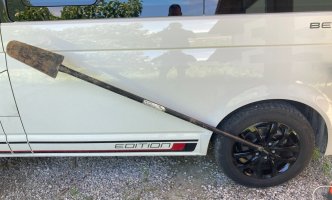sbmcd
Top Poster
VIP Member
never re-use so not relevant.So did you grease bolt threads in the gas industry? Guess not.
never re-use so not relevant.So did you grease bolt threads in the gas industry? Guess not.

Just before Christmas I had four new all weather tyres fitted at a branch of a large regional tyre company. Before taking the van in, I said to the manager that the wheels might be difficult to take off; his response, we've never been beaten yet. In the course of our discussion and without prompting, he told me "Never use copper grease when refitting a wheel. Always just wipe over the joining faces with white grease." Given that they remove and refit hundreds of wheels in a week, I am prepared to take his advice.I now apply copper grease
I've witnessed 'professional' tyre fitters torque up then "add a bit" as they put it, Had to apply your DIY method as a waste of time trying to explain/correct the practice.Now, whenever I have a wheel change carried out by a "professional", I always undo the bolts a little then re-torque them . The photo illustrates the reason, trying to undo bolts cross threaded and tightened by a moron with a windy gun.View attachment 117676
Explain? I'd be beating them over the head with the torque wrench. Although my impression is that's a tool that's only dragged out of its dusty corner when a potentially knowledgable customer is lurking around the fitting bay.I've witnessed 'professional' tyre fitters torque up then "add a bit" as they put it, Had to apply your DIY method as a waste of time trying to explain/correct the practice.
The bother to me is dramatic over tightening to the point where, if left, undoing, especially in an emergency situation can be more fraught than it need be. I'm not too worried about plus or minus a lb-ft here or there.Yep, if it bothers you, re-torque them at home.
Go on then, I’m curious, leaf springs, drum brakes and five stud wheels?Now, whenever I have a wheel change carried out by a "professional", I always undo the bolts a little then re-torque them . The photo illustrates the reason, trying to undo bolts cross threaded and tightened by a moron with a windy gun.View attachment 117676
The photo was by way of illustration, only the footwell mat is VW. The hub belonged to a 1995 Hymer on a Fiat Ducato chassis; the tyre sidewall decided to blow having been subjected to some abuse on mountain tracks in northern Greece. After fitting the spare with the three good bolts and driving carefully to the nearest habitation, the drum was removed, the sheared studs extracted from the inside and the threads re-reamed. All competently done by the only motor mechanic for miles around at a cost of twenty euros including two cups of coffee and slices of baclava. Replacement bolts couldn't be found anywhere locally, so we set off to return to the UK with four bolts in each rear wheel. Replacements were eventually found in a Romanian scrapyard.Go on then, I’m curious, leaf springs, drum brakes and five stud wheels?

Put the nuts on with the supplied brace and they’ll come off in the same way. Simple.Finally got around to putting the summer wheels/tyres onto our Beach which we bought in December . Couldn’t budge the bolts with the vehicle tool kit (I was keen to give it a go to mimic changing a wheel roadside) so I got a proper socket and bar……still no joy. Not even a good thump with a lump hammer wouldn’t do it. It took a rather extreme bar extension in the shape of my fence post spade to budge them!!
View attachment 124903
Got there in the end and torqued up properly afterwards followed by a call to the dealer!
Other observations…..the supplied wheel brace is crap. As others have suggested I’ve put a proper socket and bar in with the tool kit. The supplied jack is also horrid, I used it for one corner and then got the trolley jack out!
probably nothing like the torque required on the wheel bolts achieved with the supplied wheelbrace..Put the nuts on with the supplied brace and they’ll come off in the same way. Simple.
Search 1000+ similar discussions.
probably nothing like the torque required on the wheel bolts achieved with the supplied wheelbrace..

The VW California Club is the worlds largest resource for all owners and enthusiasts of VW California campervans.

